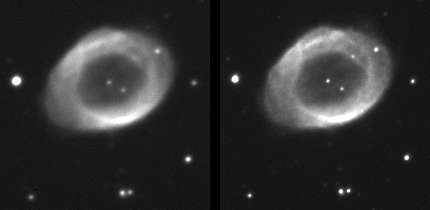 |
MODEL AO-7
ADAPTIVE OPTICS SYSTEM
September 1997
SBIG is proud to introduce another first in our field; the incorporation of adaptive optics with CCD imaging. The Model AO-7 has been specifically designed to enable an ST-7 or ST-8 user to obtain the ultimate in image resolution that his/her telescope and site achieve. SBIG has exploited the second guiding CCD detector in these imaging cameras to stabilize stellar images and enhance the resolution. The Model AO-7 has two components: a high speed tip-tilt mirror system for atmospheric correction, and new image enhancement software implementing the Lucy-Richardson algorithm.
TIP-TILT HIGH SPEED GUIDING
Utilizing the second guiding CCD as an imaging sensor, the guide star's position is read out at rates up to 40 times a second, and the tip-tilt mirror adjusted to hold the star on the designated pixel for the length of the imaging CCD's exposure. The tip-tilt mirror moves and settles to within 20% of the commanded position in a mere 10 milliseconds, dramatically faster response than any telescope drive is capable of achieving. The result is sharper stars, and more clearly defined nebular features. As a general rule one can guide at 10 frames a second on a 10th magnitude star with a 10 inch (25 cm) telescope.
The range of the mirror for the model ST-7 is +/- 50 pixels or 2 arcminutes of correction with an 80 inch focal length, enough to accommodate the periodic error of many mounts without bothering to correct the RA drive axis directly. The Model AO-7 can do all the guiding. Inexpensive telescope mounts are now entirely capable of producing well guided images. We have enclosed a product photograph and a surface plot showing the relative brightness of two stars with and without the adaptive optics system operating.
LUCY-RICHARDSON IMAGE ENHANCEMENT
SBIG, in association with Benoit Schillings and Brad Wallis, has developed a Lucy-Richardson image sharpening program that produces dramatic improvements in image detail, visually a 2x improvement. The algorithms used are similar to those used on the Hubble Space Telescope images. The results are the best we have ever seen from amateur telescopes.
The enhancement program is Windows 95 compatible, and resembles SBIG's new Windows processing products, not the well known CCDOPS which runs in the DOS environment. In addition to the enhancement capability, the program allows the display of multiple images, modification of background and range to enhance visibility of detail on the monitor, a crosshairs mode for inspecting pixel values, negative image display mode, and horizontal and vertical image flip.
The AO-7 system can be retrofitted to all Model ST-7 and ST-8 CCD imaging cameras by inserting a new ROM and loading the upgraded software that accompanies the system. This can be easily done by the user at his site. This remarkable system promises to have a profound effect on CCD imaging by reducing the atmospheric turbulence, wind induced vibrations, and eliminating the remaining periodic errors in most telescopes drives.
Production units will be available in December. The U.S. List Price will be $ 800.00. Please note that the AO-7 system will only operate with the Models ST-7 and ST-8 dual CCD imaging cameras.
The image below shows a 5 minute image of the Ring Nebula taken with an ST-7 and a Celestron C11 at prime focus (focal length = 110 inches). The image on the left was taken by Self Guiding the Losmandy G11 mount with a 1 second tracking rate. The image on the right utilized the AO-7 with a 0.05 second tracking rate and was post processed with the Lucy Richardson software (CCDSharp).
 |
To download this comparison ST-7 image in zipped SBIG format click here:RINGAVSB.ZIP
Revised: September 23, 1998 12:14:28 PM.
Copyright © 1998 Santa Barbara Instrument Group, Inc. All rights reserved.
Please report any problems with this page directly to the Webmaster